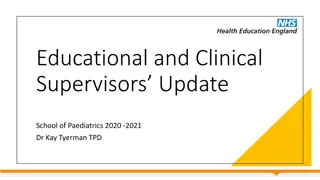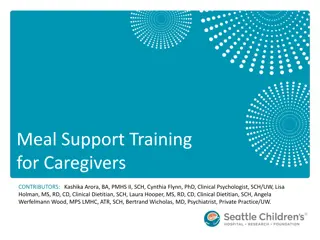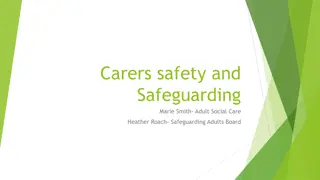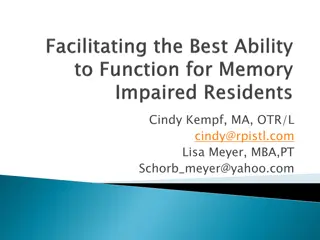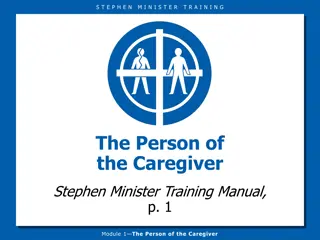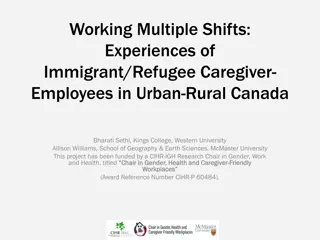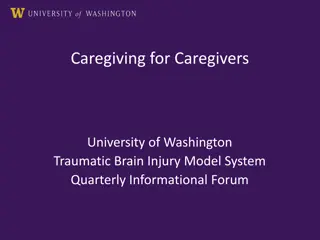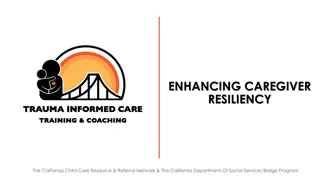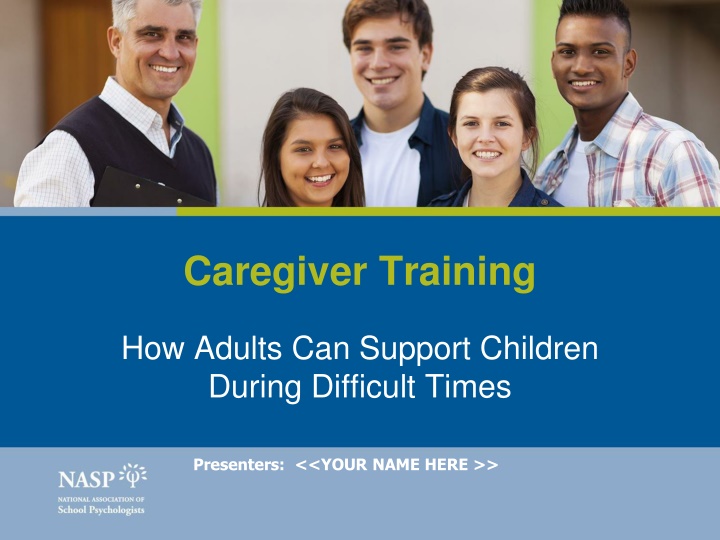
Supporting Children Through Difficult Times: Caregiver Tips
Discover valuable insights on how adults can effectively support children during challenging periods. Learn about essential facts, common reactions, appropriate responses, and when to seek additional help. Prepare for children's reactions and assist them in managing fears and concerns.
Download Presentation

Please find below an Image/Link to download the presentation.
The content on the website is provided AS IS for your information and personal use only. It may not be sold, licensed, or shared on other websites without obtaining consent from the author. If you encounter any issues during the download, it is possible that the publisher has removed the file from their server.
You are allowed to download the files provided on this website for personal or commercial use, subject to the condition that they are used lawfully. All files are the property of their respective owners.
The content on the website is provided AS IS for your information and personal use only. It may not be sold, licensed, or shared on other websites without obtaining consent from the author.
E N D
Presentation Transcript
Caregiver Training How Adults Can Support Children During Difficult Times Presenters: <<YOUR NAME HERE >>
Permission to Adapt This PowerPoint presentation is made available to school psychologists and other school crisis team members to use with families and other caregivers in their school community. Slides may be adapted and personalized to the district. Please see COVID-19 Crisis Caregiver Training Guidance for further considerations related to giving caregiver training. Delete this slide before presenting
Goals of a Caregiver Training Make sure parents, teachers, and other caregivers: 1. Know the Facts 2. Know Common Reactions 3. Know How to Respond 4. Know When to Seek More Help
Facts to Keep in Mind When crisis events occur, understanding the facts can help manage concerns, fears, and stress. In addition to deaths associated with COVID-19, others that students and staff may experience include: death of a loved one due to another illness, accidental death, suicide, loss of a pet, etc.
Facts to Keep in Mind Obtaining official facts from reliable sources can help caregivers manage truth from rumor When sharing the facts with children: Do so in an age appropriate manner Without scary and gruesome detail Let your child s questions guide the conversation
Preparing for Reactions of Children & Youth Caregivers: Understanding the crisis event facts will help you process your own feelings and reactions This will help to manage your own concerns and fears in order to better to help your child s (especially young children) fears and concerns.
Preparing for Reactions of Children & Youth Caregivers: Keep in mind your reactions will influence the reactions of your child. Children will look to the adults in their lives to have an understanding of how to respond. The initial reactions observed are common and expected after a crisis. Generally, most children adapt relatively quickly However if reactions last longer than a week or seem to worsen seek additional assistance.
Preparing for Reactions Age/Grades Common Behaviors Helplessness Agitation Heightened arousal Fears Sleep disturbances and nightmares Regression of milestones Trauma related play Fears associated with loss/abandonment of caregiver Thoughts & Feelings Confusion Difficulties/inability to understand feelings Inability to talk about feelings A lack of understanding that death is permanent Young Children & Preschool (1-5 years old)
Preparing for Reactions Thoughts & Feelings Difficulties concentrating Difficulties paying attention Difficulty recalling information Difficulty with organization Confusion Age/Grades Common Behaviors Guilt Traumatic play Discussing/retelling of the traumatic event repeatedly Sleep difficulties and nightmares Anger, aggressiveness, outbursts Sadness, crying Increased fears Separation anxiety not wanting to be away from parents Excessive worry Elementary School
Preparing for Reactions Age/Grades Common Behaviors Guilt, shame Anger, aggressiveness Withdrawal Depression Anxiety, fears, and worry Revenge fantasies Suicidal ideation Substance abuse Feelings of helplessness Thoughts & Feelings Difficulties concentrating Difficulties paying attention Difficulty recalling information Difficulty with organization School avoidance Confusion Intrusive thoughts Middle & High School
Providing Support COVID 19 Children will look to the adult and will be influenced by how the adult responds Be mindful of how you talk about the situation. The words you use can either heighten or reduce stress, fear, and anxiety. Let them know that there are other adults working to help keep people safe and healthy. Remain Calm and Reassuring
Providing Support COVID 19 Don t force conversation or discussions Help child express what they are feeling through conversations, writing, art, and play Help them to understand that their feelings are normal and it is OK to feel sad, angry, upset, and to cry. Let them know how much you care about them and love them. Be Available and Be a Good Listener
Providing Support Providing a routine and structure can be reassuring during uncertain times. Play and other activities School work Healthy Activities Sleep Eating a balanced diet regularly Exercise Maintain Routine
Recognize More Concerning Reactions Most children will manage well with natural support systems Some children may have risk factors for more intense reactions. Risk factors can include a pre-existing a mental health problem, prior traumatic experiences or abuse, family instability, or the loss of a loved one. Contact a professional if children exhibit significant changes in behavior or extreme symptoms for more than 2 weeks. 14
More Intensive Reactions Preschoolers thumb sucking, bedwetting, clinging to parents, sleep disturbances, loss of appetite, fear of the dark, regression in behavior, and withdrawal. Elementary school children irritability, aggressiveness, clinginess, nightmares, school avoidance, poor concentration, and withdrawal from activities and friends. Adolescents sleeping and eating disturbances, agitation, increase in conflicts, physical complaints, delinquent behavior, and poor concentration 15
Care for the Caregiver Taking care of yourself is vital to being able to care for your children and others in your care. Maintain healthy eating habits; get adequate sleep and exercise. Limit the use of alcohol or other substances. Know your limitations; feeling frustrated or overwhelmed is normal so take a break. Maintain normal daily routines as possible. Connect with trusted friends or family. Acknowledge that you and your family may need additional help. 16
Providing Support If reactions worsen or last more than 2 weeks, seek additional help: <<Insert link for local mental health services>>
Optional Slides 17-23 The following are slides are optional. Select the slides you wish to use and insert them into your presentation. Remove the slides you are planning not to use, including this one. 18
Grief Goal Understand that grief is a process and will take time will help caregivers help their child and themselves work though such a difficult time. Everyone grieves differently; there is no right way to grieve. Expressions of grief can include extreme sadness, anger, denial, lethargy, agitation, loneliness, loss of appetite. 19
Providing Support Be patient grief takes time Encourage and help them express their feelings o Books o Playing games o Drawing, painting, artwork Ways to Remember o Creating a Scrapbook o Looking at photo albums o Reminiscing and telling stories Reassurance Seeking support from family, friends, one s faith community or a grief counselor Helping Children Cope With Grief
COVID 19 Goal: Help give a sense of control through prevention Help reduce fear and reduce the likelihood of scary images or media 1. 2. 21
Providing Support Limit your viewing of television and other forms of media might upset your child if they are present. Talk to your child about the facts of the situation in an accurate and developmentally appropriate manner. Avoid constantly watching or looking for updates on the situation Monitor Media Viewing
What can we do to protect our children from the virus? There is currently no vaccine to prevent coronavirus disease 2019 (COVID-19). According to the Centers for Disease Control, the best way to prevent illness is to avoid being exposed to this virus. As a reminder, CDC always recommends everyday preventive actions to help prevent the spread of respiratory diseases, including: Avoid close contact with people who are sick. Avoid touching your eyes, nose, and mouth. Stay home when you are sick
What can we do to protect our children from the virus? Cover your cough or sneeze with a tissue, then throw the tissue in the trash. Clean and disinfect frequently touched objects and surfaces at home using a regular household cleaning spray or wipe. CDC does not recommend that people who are well wear a facemask to protect themselves from respiratory diseases, including COVID-19.
What can we do to protect our children from the virus? Wash your hands often with soap and water for at least 20 seconds, especially after going to the bathroom; before eating; and after blowing your nose, coughing, or sneezing. If soap and water are not readily available, use an alcohol-based hand sanitizer with at least 60% alcohol. Always wash your hands with soap and water if your hands are visibly dirty.
Additional Resources CDC Share the Facts https://www.cdc.gov/coronavirus/2019-ncov/about/share-facts-h.pdf Talking to Children About COVID 19 https://www.nasponline.org/Documents/Resources and Publications/Resources/Crisis/COVID- 19_parent_handout_NASP_NASN_2-20_FINAL.pdf Addressing Grief Brief Facts and Tips https://www.nasponline.org/resources-and-publications/resources- and-podcasts/school-climate-safety-and-crisis/mental-health- resources/addressing-grief
Additional Resources Sesame Street in the Communities: Helping Kids Grieve https://sesamestreetincommunities.org/topics/grief/ 10 Ways to Help a Grieving Child https://childrengrieve.org/resources/10-ways-to-help-a-grieving-child How to Help Kids Sort Fact from Fiction About the Coronavirus https://www.commonsensemedia.org/blog/how-to-help-kids-sort- fact-from-fiction-about-the-coronavirus



